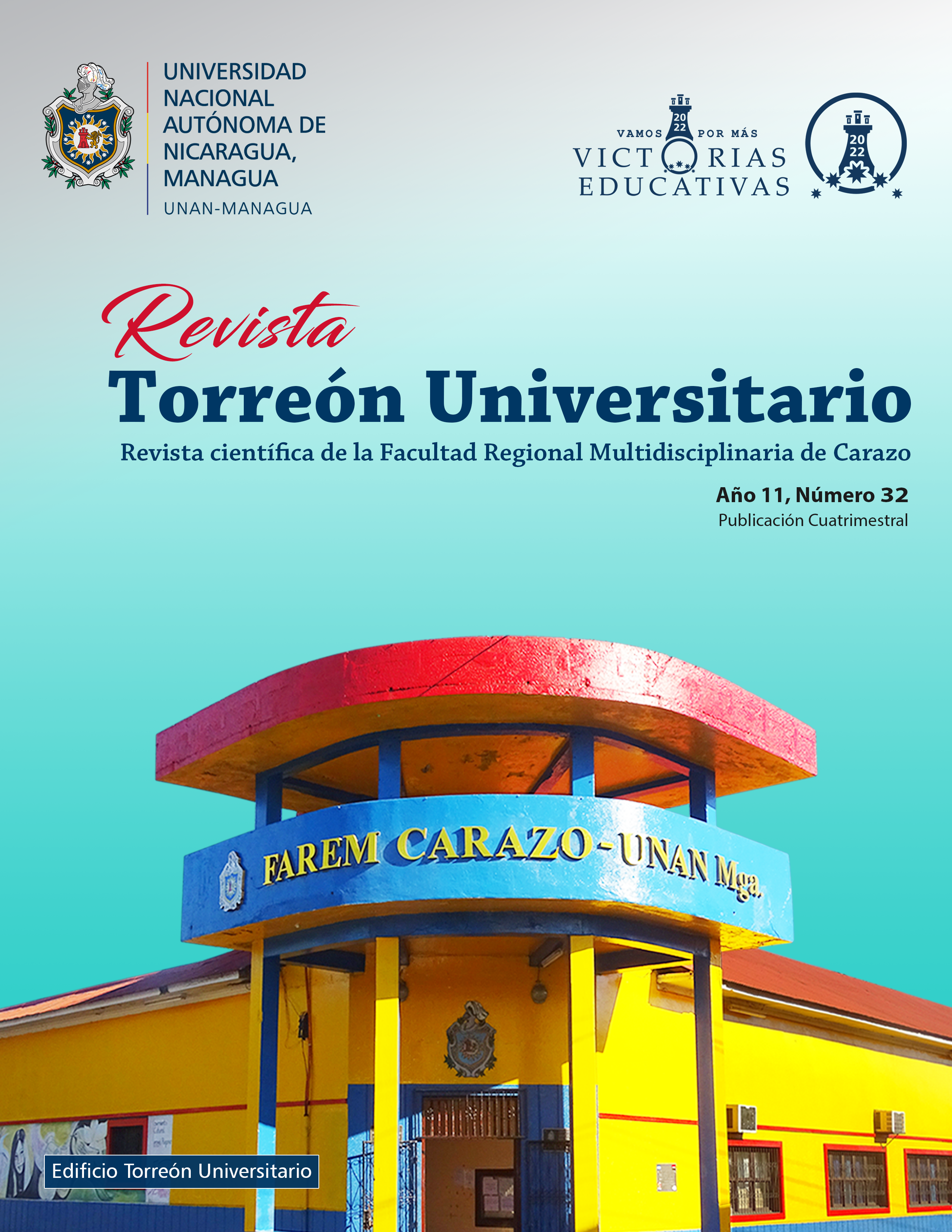Bacterial bioprospecting in sediment from the Chiquito River, in León, Nicaragua during dry and rainy seasons.
DOI:
https://doi.org/10.5377/rtu.v11i32.15034Keywords:
Bioprospecting, heavy metals, sedimentsAbstract
Two sample collection (dry and rainy season) were carried out in sediments exposed to tannery effluents and domestic wastewater (Exposed Sample); and in sediment visually contaminated by domestic wastewater (Reference Sample), with the aim of isolating and identifying bacteria according to Gram (structural) and concentrations of heavy metals of interest. The highest percentage of colonies found was in the exposed sediment, in the rainy season (66.67), identified as Gram- and the lowest was 33.33 in the same season, corresponding to Gram+. The highest enzymatic activity of lipase was in the MR in summer (3219 µg of Pnpg/10 min) and the lowest activity was obtained in the ME in winter (1710.6 µg of Pnp/g.10 min). The variation of aqueous pH and moisture content was not significant at both sites, both in the dry and rainy seasons. Hexavalent Chromium and Arsenic were not detected during the sampling periods. The texture of the sediment is sandy, which probably facilitates the transport of heavy metals. Iron concentration was similar in summer and winter, in the MR and ME (36.416 and 36.428 g.Kg -1 respectively). Lead concentrations were 12, 12,242 and 22 mg.kg-1, at the MR winter, MR summer and ME summer points, respectively; in the ME in winter it was not detected. The results suggest that, due to microbial interaction with metals, they have created resistance and tolerance through different mechanisms. It is necessary to know the minimum inhibitory concentrations of the isolated bacteria and to enhance their application in Bioremediation.
Downloads
References
Alvarado, E. O. (2019). Impacto de las actividades antropogénicas de la ciudad de León sobre la calidad del sedimento del Río Chiquito, Mayo 2016 – Enero 2017. Monografía para optar al título de Licenciatura en Química Ambiental. Obtenido de https://repositorio.unan.edu.ni/14312/
Aquiahualt Ramos, M. d., Sepúlveda, T. V., Prado Barragán, L. A., Shiraí Matsumoto, K., Ramírez Vives, F., & Salazar González, M. (2012). Manual de prácticas de laboratorio. Microbiología general.
Cubillo, F. J. (2018). Contaminantes y aprovechamiento de desechos en curtidoras de León, producir biogás y biodiesel. Revista Iberoamericana de Bioeconomia y Cambio Climático, 4(8), 954-964. doi:10.5377/ribcc. v4i8.6675
Ehrlich, H. L. (1999). Microbes as geologic agents: their role in mineral formation. Journal Geomicrobiol, 16, 135-153.
Emerson, D. (2000). Microbial oxidation of Fe(II) and Mn(II) at circumneutral pH. Environmental Metal–Microbe Interactions., 31-52.
Espitia, N. (2014). Determinación de metales pesados en sedimentos superficiales en cuerpos de agua del canal del dique en las poblaciones de Gambote y Soplavientos (Bolívar). Revista del Instituto de Investigación (RIIGEO), FIGMMG-UNMSM, 17(34), 91-100.
Leboffe, M. J., & Pierce, B. E. (2011). A Photographic Atlas for the Microbiology Laboratory.
Li, C., Quan, Q., Gan, Y., Dong, J., Fang, J., Wang, L., & Liu, J. (2020). Effects of heavy metals on microbial communities in sediments and establishment of bioindicators based on microbial taxa and function for environmental monitoring and management. Science of the Total Environment, 749.
Marrero Coto, J., Díaz Valdivia, A., & Coto Pérez, O. (2010). Mecanismos moleculares de resistencia a metales pesados en las bacterias y sus aplicaciones en la biorremediación. CENIC Ciencias Biológicas, 41(1), 67-78.
Páramo Aguilera, L. A., Delgado Silva, H. D., & Ríos Guevara, C. K. (2021). Potencial del laboratorio de biotecnología del PIESA-UNI para desarrollar bioprocesos ambientales, agrícolas e industriales. Nexo, 34(02), 534-546. Obtenido de https://doi.org/10.5377/nexo.v34i02.11540
Pucurrul, F. (2016). Expresión heteróloga de una posible manganeso oxidasa bacteriana de origen antártico. Trabajo de Grado, Licenciatura en Bioquímica.
Shao, Z., & Sun, F. (2007). Intracellular sequestration of manganese and phosphorus in a metal-resistant fungus Cladosporium cladosporioides from deep-sea sediment. Extremophiles, 11, 435-443. doi:10.1007/s00792-006-0051-0
Smets, B. F., Morrow, J. B., & Arango Pinedo, C. (2003). Plasmid Introduction in Metal-Stressed, Subsurface-Derived Microcosms: Plasmid Fate and Community Response. Applied and Environmental Microbiology, 69(7), 4087-4097.
Sobolev, D., & Begonia T, M. F. (2008). Effects of Heavy Metal Contamination upon Soil Microbes: Lead-induced Changes in General and Denitrifying Microbial Communities as Evidenced by Molecular Markers. Environmental Research and Public Health, 5(5), 450-456.
Published
How to Cite
Issue
Section
License
Copyright (c) 2022 National Autonomous University of Nicaragua, Managua.

This work is licensed under a Creative Commons Attribution-NonCommercial-NoDerivatives 4.0 International License.
The authors who publish in this journal agree to the following terms.
- The author or authors of the articles, essays or research grant the National Autonomous University of Nicaragua, Managua (UNAN-Managua) the editing rights (copyright) of the submitted work, therefore the University has the exclusive right to publish the article for the entire copyright period.
- These copyrights/authors authorize Torreón Universitario Magazine and the University to edit and disseminate/publish the article in said Magazine, including printed and electronic reproduction, storage, retrieval and any other type of publication, and sources of secondary information as services. of summaries and databases, they also empower it to protect the article against unauthorized use for dissemination by printed or electronic media (PDF, HTML, EPUB, XML or others).
License for use of content
The magazine uses the Creative Commons Attribution-NonCommercial-NoDerivs 4.0 International License.
Under this statement:

This journal is licensed under a Creative Commons Attribution-NonCommercial-NoDerivatives 4.0 International License. It can be copied, distributed and transmitted publicly as long as the author and source are cited (Revista Torreón Universitario), it should not be modified or used for any commercial purpose. The full license can be found at http://creativecommons.org/licenses/by-nc-nd/4.0/.



